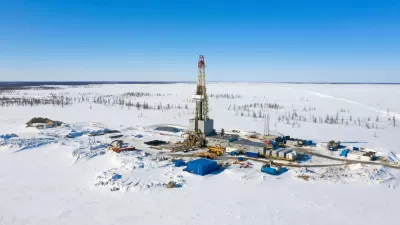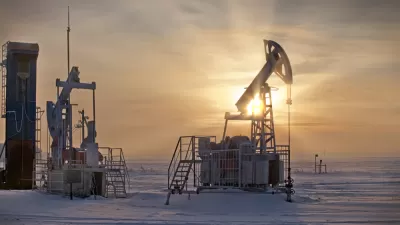If President Obama is waging a "war on coal," as his critics claim, then Europe must be enjoying a love affair with America's high-carbon fossil fuel, and the most polluting variety at that. How could the world's greenest continent turn so brown?
Unlike the United States., where the EPA, the courts and cheap natural gas has caused coal demand to plummet, demand for the high carbon fossil fuel mined in the United States is booming in Europe.
"Much of it is high-sulfur coal from under the plains of Illinois and Indiana—exactly the kind of high-emission, power-plant fuel receiving closer scrutiny from U.S. regulators and courts. Last week, the Supreme Court ruled in favor of enforcing regulations that require power plants in 28 states to cut coal emissions that blow across state lines," writes John W. Miller in The Wall Street Journal.
Low domestic demand has renewed the focus on U.S. exports, which are on track for a record-setting third straight year of more than 100 million tons. The 28-nation European Union imported 47.2 million tons of U.S. coal last year, up from 13.6 million tons in 2003 [a 247% increase]. Exports to the U.K. alone are up tenfold in the same period.
So why is "America's dirty and unwanted coal being embraced in one of the world's cleanest energy markets" at the same time that China plans to ban sulfur coal imports?
Miller points to several reasons: First, the obvious one, it's cheap, notwithstanding the significant distance it must travel. Last year the price was "as little as $65 a ton in Europe, including freight, compared with $80 a ton from U.K. mines near the Drax power plant," England's largest.
The big gainer—accounting for roughly one-third of U.S. exports, up from almost nothing 10 years ago—has been high-sulfur coal taken from thick coal seams in Illinois and Indiana. It is loaded onto barges and shipped 800 miles down the Mississippi River to a terminal on the Gulf of Mexico. From there, it heads across the Atlantic to people like Dave Docker, head of fuel procurement at Drax, who buys nine million tons of coal a year on global markets.
Miller adds that "(t)he Illinois Basin—located in Illinois, Indiana and parts of Kentucky—possesses some of the world's richest coal seams, but high sulfur and ash content caused the coal to be shunned after the passage of the Clean Air Act in 1970. By 2002, mining in Illinois reached its lowest levels since the Great Depression."
For Mr. Docker, the coal's low cost is a saving grace. He has made enough other improvements to plant operations—in particular, new technology to remove sulfur better [as much as 90%]—to allow Drax to burn cheap dirty coal and still comply with strict EU laws. [See related WSJ article, 2006].
Turns out that Drax is also burning cleaner coal from Russia and Columbia "that contains less than 1% sulfur, compared with the 2.5%-3% sulfur content of Illinois Basin coal." Burning the low sulfur coal, biomass fuel, and use of scrubbers enables Drax to meet sulfur-emissions quota set by EU regulators in 2005.
At the same time, Drax also started burning dried vegetation that emits almost no sulfur and reduced the amount of coal needed. One of Drax's six boilers now burns biomass, or compressed plant and wood material, much of it imported from the U.S. The plan is to convert two more of the boilers to biomass fuel by 2020. [This practice is also done by U.S. power plants to reduce emissions, as noted here.].
Miller points to two additional reasons why European power plants turned to coal, particularly the cheaper American variety.
Germany's decision to phase out of nuclear power after the 2011 Fukushima nuclear disaster in Japan has also made it a significant buyer of U.S. coal, mostly because the commodity is so inexpensive.
"Before the financial crisis, Europe was happy to favor the environment, but when the economy started not doing well, they weren't quite ready to accept the high power price," so energy consumers returned to coal, says Daniel Rohr, an analyst for Morningstar Inc.
When will Europe return to its green energy roots? "Many EU countries are in violation of the bloc's emissions rules, and 19 have been subject to formal complaints from the European Commission," adds Miller.
Not soon enough according to Tara Connolly, an energy staffer for Greenpeace EU Unit in Brussels, who advocates ending the sulfur quotas as the best means to get there.
FULL STORY: Dirty U.S. Coal Finds a Home in Europe

Study: Maui’s Plan to Convert Vacation Rentals to Long-Term Housing Could Cause Nearly $1 Billion Economic Loss
The plan would reduce visitor accommodation by 25,% resulting in 1,900 jobs lost.

North Texas Transit Leaders Tout Benefits of TOD for Growing Region
At a summit focused on transit-oriented development, policymakers discussed how North Texas’ expanded light rail system can serve as a tool for economic growth.

Why Should We Subsidize Public Transportation?
Many public transit agencies face financial stress due to rising costs, declining fare revenue, and declining subsidies. Transit advocates must provide a strong business case for increasing public transit funding.

How to Make US Trains Faster
Changes to boarding platforms and a switch to electric trains could improve U.S. passenger rail service without the added cost of high-speed rail.

Columbia’s Revitalized ‘Loop’ Is a Hub for Local Entrepreneurs
A focus on small businesses is helping a commercial corridor in Columbia, Missouri thrive.

Invasive Insect Threatens Minnesota’s Ash Forests
The Emerald Ash Borer is a rapidly spreading invasive pest threatening Minnesota’s ash trees, and homeowners are encouraged to plant diverse replacement species, avoid moving ash firewood, and monitor for signs of infestation.
Urban Design for Planners 1: Software Tools
This six-course series explores essential urban design concepts using open source software and equips planners with the tools they need to participate fully in the urban design process.
Planning for Universal Design
Learn the tools for implementing Universal Design in planning regulations.
City of Santa Clarita
Ascent Environmental
Institute for Housing and Urban Development Studies (IHS)
City of Grandview
Harvard GSD Executive Education
Toledo-Lucas County Plan Commissions
Salt Lake City
NYU Wagner Graduate School of Public Service




























